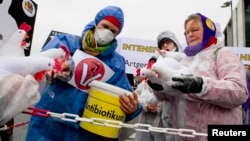WASHINGTON —
U.S. regulators and livestock producers have failed to curb the use of antibiotics in livestock despite concerns that excessive use in meat production will reduce the drugs' effectiveness in humans, said a panel of experts.
“Meaningful change is unlikely in the future,” concluded the 14-member panel, assembled by Johns Hopkins University, in a report released on Tuesday.
The release marked the fifth anniversary of a landmark 2008 Pew Charitable Trust report that called for an end to the sub therapeutic use of antibiotics by livestock producers, as well as an end to practices such as tiny cages for laying hens.
Congressional hearings followed the release of that report, and the livestock industry went into damage control mode.
Antibiotics are routinely sprinkled into U.S. cattle, hog and poultry feed, not only to prevent and treat illness but to promote growth. Agriculture accounts for 80 percent of antibiotic sales, according to the limited records available.
The Johns Hopkins' report said “additional scientific evidence has strengthened the case that these [non therapeutic] uses pose unnecessary and unreasonable public health risks” of allowing bacteria to develop resistance to antibiotics.
“There has been an appalling lack of progress,” said director Robert Lawrence of the Johns Hopkins Center for a Livable Future, which produced the report. He said lack of action by Congress and federal regulators and the “intransigence of animal agriculture industry” had made the problems worse.
The panel that wrote the Johns Hopkins report included ranchers, public health experts, the former dean of a veterinary school and former U.S. Agriculture Secretary Dan Glickman. Its chairman was former Kansas Governor John Carlin.
Loopholes
While the U.S. Food and Drug Administration has altered its guidelines to say antibiotics should be used only under the guidance of a veterinarian for prevention, control or treatment of disease, the Johns Hopkins report said there was a loophole. Drugs can be approved for disease prevention on the proviso that they are not being used as part of livestock production.
“This means that while antimicrobial approvals may change ... antimicrobial use may not,” said the report.
An FDA spokesman was not immediately available for comment.
A livestock group, the Animal Agriculture Alliance, said in its own report - released to coincide with the Johns Hopkins study - that the FDA guidelines will assure medically important antibiotics are used by farmers and ranchers only to combat disease.
Richard Raymond, a former agriculture undersecretary for food safety, said in the alliance report that antibiotics are part of an array of biological tools for livestock producers.
Raymond listed them along with beta-agonists, a type of feed additive that helps animals gain weight faster, and man-made bovine hormones which are used to boost dairy production.
U.S. drugmaker Merck & Co. suspended U.S. and Canadian sales of Zilmax, the leading beta-agonist, on Aug. 16 following concerns about cattle who appeared to be sore-footed or were having difficulty walking after being fed the additive.
“Meaningful change is unlikely in the future,” concluded the 14-member panel, assembled by Johns Hopkins University, in a report released on Tuesday.
The release marked the fifth anniversary of a landmark 2008 Pew Charitable Trust report that called for an end to the sub therapeutic use of antibiotics by livestock producers, as well as an end to practices such as tiny cages for laying hens.
Congressional hearings followed the release of that report, and the livestock industry went into damage control mode.
Antibiotics are routinely sprinkled into U.S. cattle, hog and poultry feed, not only to prevent and treat illness but to promote growth. Agriculture accounts for 80 percent of antibiotic sales, according to the limited records available.
The Johns Hopkins' report said “additional scientific evidence has strengthened the case that these [non therapeutic] uses pose unnecessary and unreasonable public health risks” of allowing bacteria to develop resistance to antibiotics.
“There has been an appalling lack of progress,” said director Robert Lawrence of the Johns Hopkins Center for a Livable Future, which produced the report. He said lack of action by Congress and federal regulators and the “intransigence of animal agriculture industry” had made the problems worse.
The panel that wrote the Johns Hopkins report included ranchers, public health experts, the former dean of a veterinary school and former U.S. Agriculture Secretary Dan Glickman. Its chairman was former Kansas Governor John Carlin.
Loopholes
While the U.S. Food and Drug Administration has altered its guidelines to say antibiotics should be used only under the guidance of a veterinarian for prevention, control or treatment of disease, the Johns Hopkins report said there was a loophole. Drugs can be approved for disease prevention on the proviso that they are not being used as part of livestock production.
“This means that while antimicrobial approvals may change ... antimicrobial use may not,” said the report.
An FDA spokesman was not immediately available for comment.
A livestock group, the Animal Agriculture Alliance, said in its own report - released to coincide with the Johns Hopkins study - that the FDA guidelines will assure medically important antibiotics are used by farmers and ranchers only to combat disease.
Richard Raymond, a former agriculture undersecretary for food safety, said in the alliance report that antibiotics are part of an array of biological tools for livestock producers.
Raymond listed them along with beta-agonists, a type of feed additive that helps animals gain weight faster, and man-made bovine hormones which are used to boost dairy production.
U.S. drugmaker Merck & Co. suspended U.S. and Canadian sales of Zilmax, the leading beta-agonist, on Aug. 16 following concerns about cattle who appeared to be sore-footed or were having difficulty walking after being fed the additive.








